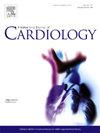Midterm outcomes of thoracoscopic trans-mitral myectomy for hypertrophic obstructive cardiomyopathy: A single-center, observational study
IF 3.2
2区 医学
Q2 CARDIAC & CARDIOVASCULAR SYSTEMS
引用次数: 0
Abstract
Background
Hypertrophic obstructive cardiomyopathy (HOCM) is traditionally treated with septal myectomy via sternotomy. Thoracoscopic trans-mitral myectomy (TTM) is a minimally invasive alternative, but midterm outcomes remain unclear. We aimed to evaluate the midterm efficacy and safety of TTM versus open trans-aortic myectomy (OTM) in obstructive HOCM patients.
Methods
A retrospective cohort study was conducted at a single institution, including patients who underwent either TTM or OTM from January 2020 to December 2023. Primary endpoints included changes in echocardiographic parameters (left ventricular outflow tract [LVOT] gradient, septal thickness, left ventricular volume, and mitral regurgitation severity) and functional improvement (NYHA class). Secondary outcomes included complications, re-intervention, and survival at 12 months.
Results
A total of 102 patients were included, with 57 undergoing TTM and 45 undergoing OTM. Both techniques led to significant reductions in LVOT gradient and septal thickness (both p < 0.001), with no significant intergroup differences. TTM showed superior improvement in mitral regurgitation severity, with moderate-to-severe mitral regurgitation decreasing from 42 % to 9 % versus 38 % to 20 % in OTM (p < 0.05). Functional status improved, with 88 % of TTM and 87 % of OTM patients achieving NYHA class I at 12 months. No significant differences were observed with respect to re-interventions or 12-month survival.
Conclusions
TTM is a safe and effective alternative to OTM for HOCM, offering similar relief of LVOT obstruction and functional improvement, with superior reduction in mitral regurgitation severity. Larger, multicenter studies are needed to confirm these findings and define TTM's role in HOCM management.

求助全文
约1分钟内获得全文
求助全文
来源期刊

International journal of cardiology
医学-心血管系统
CiteScore
6.80
自引率
5.70%
发文量
758
审稿时长
44 days
期刊介绍:
The International Journal of Cardiology is devoted to cardiology in the broadest sense. Both basic research and clinical papers can be submitted. The journal serves the interest of both practicing clinicians and researchers.
In addition to original papers, we are launching a range of new manuscript types, including Consensus and Position Papers, Systematic Reviews, Meta-analyses, and Short communications. Case reports are no longer acceptable. Controversial techniques, issues on health policy and social medicine are discussed and serve as useful tools for encouraging debate.
 求助内容:
求助内容: 应助结果提醒方式:
应助结果提醒方式:


